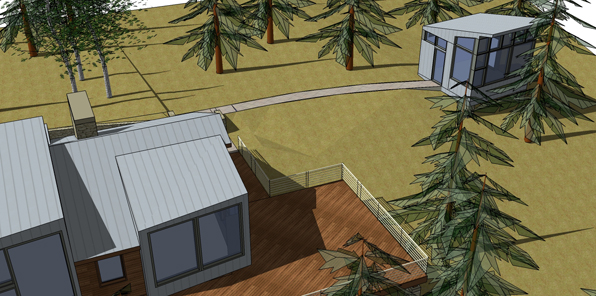In the past few years I have had the opportunity to work on a number of projects that fully incorporated a live-work dynamic as a fundamental part of the house. More than simply a home office, a fully-utilized live-work program creates a kind of tension of use and privacy that most homes in the last one hundred years or so have not encountered.

Most of the projects like this that we have worked on included a single large office or studio. And the variety of work has differed greatly but all with one similar aspect - the ability, via computers and the internet, to communicate visually, verbally and to a great degree of satisfaction - with a remote office or clients. Rarely do these home offices or studios include a separate entry for clients or employees because the work in question does not require it. More often, my clients work at home and take the drive to the airport on a regular and frequent schedule to meet with their clients and co-workers.
So what is the nature then of these home offices? They are not the 19th century gentlemen's study, a place of retreat and contemplation. They are wired and connected not just functionally, but also culturally, to distant places and all to the landscape that is the internet. More trips are taken to Google than the local coffee shop. What is the nature of "privacy" in a space in your house that is open to so much of the world with the only "threshold" of a keyboard and/of mouse?
In looking at these projects and working on some current live-work projects, what occurs to me is that in each project we have tried to ritualize the passage in the house from the working space back and forth to the rest of the house. In the images above, for a condo renovation, the office was on a half-level between the main level living spaces and the upper floor master bedroom. We focused effort on the stair and tried to create a unique space, with light streaming down from skylights, to set this passage off from the more conventionally proportioned rooms. In addition, we installed a series of semi-transparent resin panels on both sides of the stair to modulate the sound and views from the office to the rest of the house. The public-private dialogue that takes place across this stair makes a kind of liminal threshold that makes the mental shift to and from "working".
In the project above, we designed a simple writer's shack as an additional outbuilding to a cabin renovation in rural Colorado. The shifted geometry of the writer's shack reverberates back through the cabin as series of new dormers, inserting the "working" within the "living". And again, the path between the buildings, a simple path through the woods, is designed as a careful separation - just far apart for a sense of separation, but not too isolating. That ritual of walking between the two, with a cup of coffee in hand, boots on but not laced up, the pupils adjusting to and from the bright, Colorado high-alpine sunshine, makes each building a distinct place, the occupation intentional.
The image above is a home office we designed, very warm and internalized, that looks out to a mountain vista. This is a built analogue of the relationship of the home-based office, secure and private, looking out via the internet, to the rest of the electronic world.
I'm not sure how the issues of the private office and the public connectivity play out for a project - that relationship varies with each client and each space. I do know however that just putting a desk in an unused bedroom does not really address the live-work issue and forsakes a potentially rich landscape of ideas and use that is architecture.



